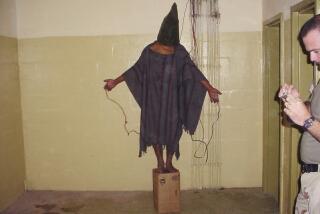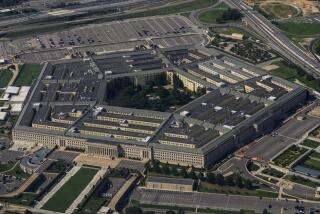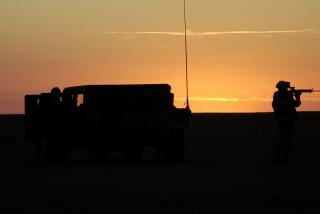When Troops Went to Persian Gulf So Did Military Justice
- Share via
U.S. troops arrived in the Persian Gulf with more than just an impressive array of computerized weapons and other technological wonders.
Marching in lock-step with the servicemen and servicewomen was an invisible but omnipresent corps of military judges and lawyers whose mission was to ensure that justice be carried out in hundreds of cases in which U.S. troops were charged with violations of the Uniform Code of Military Justice.
The UCMJ, as it is commonly known in the U.S. military, is the code of laws that governs the conduct of all persons in the armed forces. The code prescribes punishment for felony and misdemeanor violations of military law. Trials take place on sea or land at literally all hours of the day or night.
Military officials frequently point out that America’s armed forces are a microcosm of U.S. society. So it should come as no surprise that, even while they prepared to battle the Iraqi army, some American troops also were engaged in crimes that in many cases were no different from those investigated daily by civilian authorities in any U.S. city.
Because of the limited contact with local civilians during the Persian Gulf War, virtually all of the courts-martial stemming from the conflict were for crimes committed by American troops against each other.
During Operation Desert Shield, the buildup that began Aug. 2, 1990, for the war with Iraq, and Operation Desert Storm, the offensive against Iraq that began Jan. 17, 1991, U.S. troops were court-martialed for a variety of crimes, ranging from relatively mild violations like lying to more serious charges like rape and manslaughter.
Court-martial documents obtained by The Times and interviews with military officials showed that most of the charges lodged against U.S. troops were routine by military standards. But the court records, which pertained to sailors and Marines from San Diego-area commands who were court-martialed, also provided a rare view of the military’s unique culture.
For example, a Navy sailor was court-martialed for jumping off the carrier Independence while the giant ship was steaming in the Northern Arabian Sea on Aug. 9, 1990.
In addition to being charged with “wrongfully and intentionally” jumping off the ship, the sailor was also charged with resisting a “search-and-rescue swimmer” who was ordered to pluck him out of the water. He also was charged with failure to report to his duty station on the ship.
The unidentified sailor was tried by a special court-martial, but the charge that he resisted rescue was dismissed. On Aug. 28, 1990, after a trial that lasted less than three hours, he was convicted on the remaining charges, and a military judge sentenced him to the brig for two months, reduced his rank, fined him $800 and issued a bad-conduct discharge.
Hundreds of other cases involving minor infractions were settled by unit commanders who meted out what the military calls “non-judicial punishment.” In most of these cases offenders were punished by confinement to quarters, reduction in pay or rank or additional duty.
Navy records showed that 96 sailors and Marines serving aboard Navy ships and under Navy commands were court-martialed in Navy courts while serving in Desert Shield and Desert Storm from Aug. 2, 1990, to April 16, 1991. The records showed that 62 of the 96 trials were held in Saudi Arabia. The others were held aboard ships or at other Navy bases.
The records obtained by The Times showed that at least 32 of the 96 courts-martial involved sailors from San Diego-area commands. Lt. Bob Ross, Navy spokesman in Washington, said figures for Navy cases settled by non-judicial punishment were unavailable.
According to the Navy records, only five of the 96 people charged with court-martial offenses were acquitted.
At least two servicemen (military officials said they did not know of any servicewomen who were court-martialed during the Persian Gulf War) were charged with manslaughter by Navy prosecutors. However, Navy officials were unable to say whether either of the manslaughter cases resulted in convictions.
Navy records also showed that six people were charged under the UCMJ section that prosecutors use to convict defendants for both attempted murder and sodomy. Officials were unable to say how many prosecutions were for attempted murder and how many were for sodomy, or whether any of the cases resulted in convictions.
One of the courts-martial was for rape, but again, Navy officials could not say whether the trial resulted in a conviction.
Lt. Kimberley Miller, Marine Corps spokeswoman in Washington, said 100 Marines were court-martialed in Marine military courts while serving in operations Desert Shield and Desert Storm. However, Miller could not say how many of the cases resulted in convictions or acquittals.
Records obtained by The Times showed that at least 23 of the 100 cases involved Marines attached to the 1st Marine Division, which is based at Camp Pendleton. A base spokesman said all 23 cases resulted in convictions, but he said not all of the Marines were from Camp Pendleton. During the Persian Gulf War, Marines from other units were attached temporarily to the 1st Marine Division.
In addition, 648 other cases involving Marines were settled by local commanders through non-judicial punishment, Miller said. About 92,000 Marines served in the Persian Gulf.
Military officials pointed out that the majority of courts-martial were for relatively minor offenses like being AWOL, or absent without leave; insubordination; malingering; and showing disrespect to a superior.
However, other cases also involved serious charges like assault, attempted murder, manslaughter and selling drugs.
Here are some of the more interesting cases reviewed by The Times:
A drunken sailor from an unnamed ship on leave in Singapore on Oct. 27, 1990, was convicted of a variety of charges that included allegations that he stole a civilian motorcycle and police car. He also was convicted of resisting arrest by Singapore police and causing $900 damage to the Thai Embassy in Singapore. One of the items damaged at the embassy was a bedroom door.
The sailor, who apparently was heavily intoxicated, also was convicted of banging a Singapore policeman’s head against the side of a Mercedes-Benz owned by the Thai Embassy. Although he was convicted of breaking into the Thai ambassador’s bedroom at the Thai Embassy, he was found not guilty of stealing the ambassador’s Mercedes.
Another sailor from the Independence was convicted of having 600 doses of the hallucinogenic drug LSD aboard the ship Nov. 27, 1990. His two-day court-martial began Dec. 3, and he was convicted on five drug charges.
A sailor from the carrier Ranger was convicted Jan. 1, 1991, of 13 counts stemming from charges that he possessed 50 phony military identification cards and sold 25 of the false documents to other sailors.
Another Ranger sailor was convicted April 25, 1991, on nine counts stemming from charges that he engaged in loan-sharking from Nov. 15, 1900 to Dec. 1, 1990. The sailor was accused of “wrongfully engaging in trade or business . . . without permission of the commanding officer.”
Navy justice is not only swift but it apparently also is not hampered by time constraints. A sailor assigned to the Ranger was convicted on five counts stemming from charges that he stole a $200 postal money order. His trial took place at 10:30 p.m. aboard ship.
Unlike their Navy counterparts, Marine officials did not hide the names of Marines who were convicted in courts-martial. At least two Marine enlisted men assigned to the 1st Marine Division at Camp Pendleton were charged with raping two enlisted women while serving in Saudi Arabia.
However, both men, Staff Sgt. Maurice Knight and Cpl. Daniel L. Weaver Jr., were cleared of the rape charges. Records of Knight’s court-martial were unavailable. However, Weaver was convicted of adultery and illegally consuming alcohol.
Most of the cases involving Camp Pendleton Marines reviewed by The Times evolved from incidents in the Arabian desert. And, the majority involved Marines pointing loaded weapons at other Marines, firing weapons in an unsafe manner or loading a weapon without proper authority.
The UCMJ provides for three kinds of court-martial: summary, special and general. A commissioned officer sits as the trial judge.
In a summary court-martial, a single officer usually acts as judge and both defense and prosecuting attorney. Summary courts-martial are held in cases where the charges are too serious for non-judicial punishment but not serious enough for special and general courts-martial. A person convicted in a summary court can be sentenced to no more than 30 days in custody but cannot receive a punitive discharge.
Military personnel convicted in a special court-martial can receive a maximum of six months in custody, be ordered to forfeit up to two-thirds of pay, be reduced in rank and receive a bad-conduct discharge.
General courts-martial are used for more serious cases like murder and rape. The judge at a military court-martial can impose the death penalty or life in prison as punishment.
More to Read
Sign up for Essential California
The most important California stories and recommendations in your inbox every morning.
You may occasionally receive promotional content from the Los Angeles Times.










